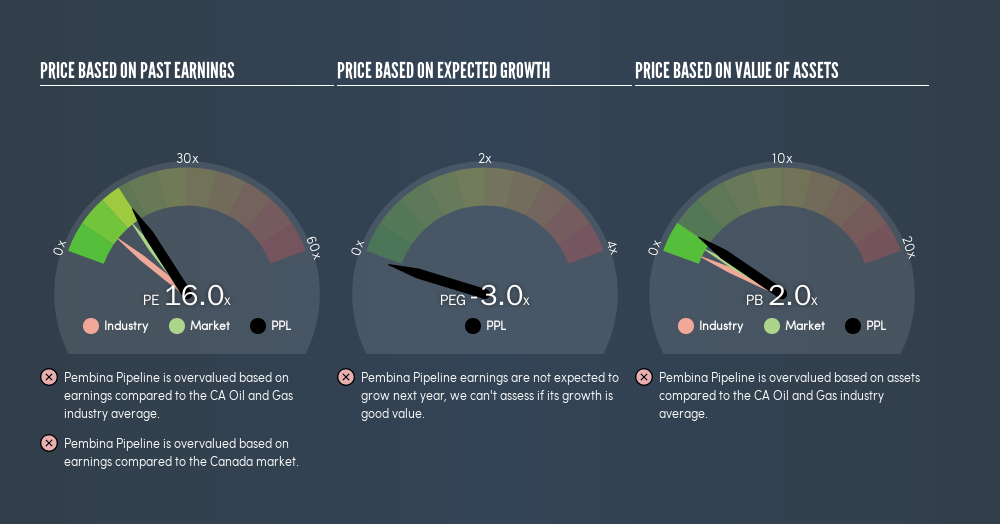
This article is for investors who would like to improve their understanding of price to earnings ratios (P/E ratios). We'll show how you can use Pembina Pipeline Corporation's (TSE:PPL) P/E ratio to inform your assessment of the investment opportunity. Pembina Pipeline has a price to earnings ratio of 16, based on the last twelve months. That means that at current prices, buyers pay CA$16 for every CA$1 in trailing yearly profits.
View our latest analysis for Pembina Pipeline
How Do I Calculate Pembina Pipeline's Price To Earnings Ratio?
The formula for P/E is:
Price to Earnings Ratio = Price per Share ÷ Earnings per Share (EPS)
Or for Pembina Pipeline:
P/E of 16 = CA$48.95 ÷ CA$3.06 (Based on the trailing twelve months to June 2019.)
Is A High Price-to-Earnings Ratio Good?
The higher the P/E ratio, the higher the price tag of a business, relative to its trailing earnings. That isn't a good or a bad thing on its own, but a high P/E means that buyers have a higher opinion of the business's prospects, relative to stocks with a lower P/E.
How Does Pembina Pipeline's P/E Ratio Compare To Its Peers?
The P/E ratio indicates whether the market has higher or lower expectations of a company. As you can see below, Pembina Pipeline has a higher P/E than the average company (8.1) in the oil and gas industry.

That means that the market expects Pembina Pipeline will outperform other companies in its industry.
How Growth Rates Impact P/E Ratios
Earnings growth rates have a big influence on P/E ratios. If earnings are growing quickly, then the 'E' in the equation will increase faster than it would otherwise. That means unless the share price increases, the P/E will reduce in a few years. A lower P/E should indicate the stock is cheap relative to others -- and that may attract buyers.
Notably, Pembina Pipeline grew EPS by a whopping 43% in the last year. And its annual EPS growth rate over 5 years is 21%. I'd therefore be a little surprised if its P/E ratio was not relatively high.
Don't Forget: The P/E Does Not Account For Debt or Bank Deposits
One drawback of using a P/E ratio is that it considers market capitalization, but not the balance sheet. That means it doesn't take debt or cash into account. In theory, a company can lower its future P/E ratio by using cash or debt to invest in growth.
Spending on growth might be good or bad a few years later, but the point is that the P/E ratio does not account for the option (or lack thereof).
Is Debt Impacting Pembina Pipeline's P/E?
Pembina Pipeline has net debt equal to 30% of its market cap. While it's worth keeping this in mind, it isn't a worry.
The Verdict On Pembina Pipeline's P/E Ratio
Pembina Pipeline trades on a P/E ratio of 16, which is above its market average of 13.8. Its debt levels do not imperil its balance sheet and its EPS growth is very healthy indeed. So on this analysis a high P/E ratio seems reasonable.
Investors should be looking to buy stocks that the market is wrong about. People often underestimate remarkable growth -- so investors can make money when fast growth is not fully appreciated. So this free report on the analyst consensus forecasts could help you make a master move on this stock.
But note: Pembina Pipeline may not be the best stock to buy. So take a peek at this free list of interesting companies with strong recent earnings growth (and a P/E ratio below 20).
We aim to bring you long-term focused research analysis driven by fundamental data. Note that our analysis may not factor in the latest price-sensitive company announcements or qualitative material.
If you spot an error that warrants correction, please contact the editor at editorial-team@simplywallst.com. This article by Simply Wall St is general in nature. It does not constitute a recommendation to buy or sell any stock, and does not take account of your objectives, or your financial situation. Simply Wall St has no position in the stocks mentioned. Thank you for reading.
About TSX:PPL
Established dividend payer and fair value.
Similar Companies
Market Insights
Community Narratives





